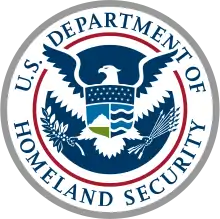Global Entry
Global Entry is a program of the U.S. Customs and Border Protection service that allows pre-approved, low-risk travelers to receive expedited clearance upon arrival into the United States via the SENTRI and NEXUS lanes and through automatic kiosks at select airports. As of May 4, 2018, Global Entry was available at 53 US airports and 15 preclearance locations.[1][2] By April 2018 more than 5 million people were enrolled in Global Entry[3] and approximately 50,000 new applications for the program were being filed monthly.

Enrollment
To enroll in Global Entry, applicants must first file an application with Customs and Border Protection, and then submit to an interview and background check. After submission, applicants must wait for either conditional approval or rejection. If conditionally approved, all first-time applicants must schedule an appointment for an interview, photograph and finger prints. The wait for an interview may be months to a year.[4] There is no minimum number of international trips required to qualify for the Global Entry program: in fact, applicants qualify without any history or plans of international travel.
There is a $100 non-refundable fee due at the time of application (before consideration for conditional approval). Unlike other trusted traveler programs, like NEXUS, the fee applies to infants and children (some credit cards reimburse this fee to both the cardholder and household family members).[5]
During the interview, the applicant's fingerprints are captured and a digital photo is taken. Applicants are also given instructions on how to use the automated kiosk. The applicant is not approved on-site. Instead, the program (CBP) sends both an email notification and a U.S. Mail letter stating the outcome. The email directs applicants to login to their DHS TTP portal to view the outcome (though it's not necessary). The physical letter may contain a membership ID card (typically only included if requested via the DHS TTP web portal). However, the card is neither required for any aspect of the program and also cannot be used at kiosks (i.e., a passport is still required).
An advantage to viewing the status online is that, if approved, the Known Traveler ID ("KTN," required to be provided to participating airlines in order to receive TSA Precheck) is supplied and may be used immediately. Otherwise, the approved applicant has to wait for their KTN in the physically mailed letter.
Although an ID card serves no purpose during customs interactions, it can be used as a photo ID at U.S. airports. Further, airports without dedicated Precheck lanes occasionally allow cardholding members to bypass standard security: while they wait in line, a special paper is given and provided to the x-ray operator letting them know that the member does not need to remove liquids, computer or clothing. However, this practice is much more common for after-hours use (i.e., this process is often used once the staffed, dedicated Precheck lane is closed). The card is also NTHI-compliant, meaning it can be used at U.S. land and sea crossings into the U.S. from Canada and Mexico. The card is RFID enabled, so it can be used in Ready lanes at such border checkpoints (an RFID enabled card is required for SENTRI, NEXUS and Ready lanes because data must read wirelessly in advance to allow border guards to pre-process passengers before their vehicle arrives at the crossing station).
Once an application is approved, the applicant may use the Global Entry kiosk at any participating airport for a duration of five years. The five year period begins at the member's next birthday following approval. So for instance, an applicant with a birthday in October who is approved in May (i.e., 5 months prior to their birthday) will enjoy 5 years + 5 months of privileges.
Renewal of membership requires an additional fee (currently, the same $100 fee as charged for new applicants), and in some cases, renewal applicants are selected for a new interview.[6][7][8] The TSA maintains a list of credit card issuers and loyalty programs that reimburse members' TSA PreCheck and/or Global Entry application fees.[9]
Entry procedure
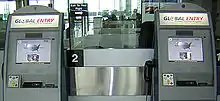
Air
Enrolled users must present their machine-readable passport or permanent residency card, and submit their fingerprints to establish identity. Users then complete a computerized customs declaration, and are issued a receipt instructing them to either proceed to baggage claim, or to a normal inspection booth for an interview.[10] For subsequent entries at certain facilities (e.g., NEXUS), only a facial recognition scan is required instead of the passport (however users are always advised to travel with a passport when abroad).
Land and sea
Enrolled users are provided with an RFID-enabled Global Entry membership card that may be used to enter the United States via expedited "Ready Lanes," akin to NEXUS lanes from Canada, or SENTRI lanes from Mexico. The card may also be used at sea ports of entry. The Global Entry Card cannot be used to enter Canada.[11]
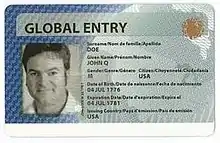
Enrollment eligibility
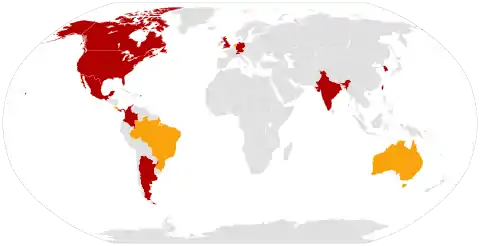
As of March 2020, nationals of the following countries may apply for Global Entry:[12]
 Argentina
Argentina Colombia
Colombia Germany
Germany India
India Mexico
Mexico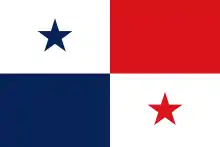 Panama
Panama Singapore
Singapore South Korea (members of Smart Entry Service)
South Korea (members of Smart Entry Service) Switzerland
Switzerland Taiwan
Taiwan United Kingdom (British citizens only[13])
United Kingdom (British citizens only[13]) United States (nationals and permanent residents)
United States (nationals and permanent residents)
Nationals and permanent residents of Canada are not eligible to apply for Global Entry but they may apply for NEXUS, whose members have all benefits of Global Entry including using Global Entry kiosks.
Nationals of the Netherlands could apply for Global Entry before 2017, and existing members may continue using and renew the program. A new program to apply has been delayed for years but may be up within weeks.[14]
Australia[15] and Brazil[16] are expected to start participation in Global Entry in 2020, after a trial with a small number of their nationals. Costa Rica has also negotiated participation in the program.[17]
Disqualification and revocation
Any type of criminal conviction can disqualify a traveler from the Global Entry program: it is a risk-based system to facilitate the entry of pre-approved travelers. Three to five percent of travelers who sign up for the program are rejected; in such cases, they are generally told the reason for the rejection. Applicants may not qualify if they provide false or incomplete information on the application, if they have pending criminal charges or for any other legal/customs issues (particularly, but not exclusively, for customs-related offenses) such as, for example, having previously paid a fine for transporting a prohibited or undeclared item at a port of entry in the U.S. or even abroad.
Those whose Global Entry applications are denied have three ways to appeal: making an appointment to speak with a supervisor at a trusted traveler enrollment center, e-mailing the CBP Trusted Traveler Ombudsman, or filing a complaint through the Department of Homeland Security's Traveler Redress Inquiry Program.[18]
CBP claims that less than one percent of active Global Entry participants' privileges are revoked. In these situations, an explanation for the revocation is not necessarily supplied.[19]
2020 lawsuit by New York State
New York's recently enacted immigrant sanctuary "Green Light Law" prohibits its state DMV from sharing criminal records with the federal Customs and Border Protection (CBP) or Immigration and Customs Enforcement (ICE) without a court order.[20] (New York provides driver's licenses to undocumented immigrants, as over a dozen other states also do, though none of those other states placed as tight restrictions on the federal government's access to DMV records.)[21]
In response to this law, on February 6, 2020, the Department of Homeland Security announced that it would immediately begin prohibiting New York state residents from applying for or renewing Trusted Traveler programs including Global Entry. This affects about 175,000 New Yorkers whose Trusted Traveler memberships will expire in 2020 and another 80,000 New Yorkers with pending applications.[22][23][24] The Trump administration said it would reinstate the Trusted Traveler program if New York state opened its DMV records to the federal government.
New York did not immediately agree to these terms. The next day, state officials promised to sue the Trump administration. They said the lawsuit would argue that "the federal government’s actions were arbitrary and capricious, did not provide state residents equal protection and violated the state’s sovereign immunity," as The New York Times explained.[21] New York attorney general Letitia James filed the lawsuit against CBP and DHS on February 10.[22]
However, on February 12, Gov. Andrew Cuomo said he would comply with the Trump administration's request. He said he would propose either a legislative bill or a change to the New York state budget to grant the federal government access to New York's motor vehicle data (but only to the records of Trusted Traveler applicants and members, and only on a case-by-case basis). If the change is introduced by this method, it will likely not take effect for several months. This was to be done in exchange for the Trump administration reopening the Trusted Traveler program for New Yorkers.[25] On February 13, Cuomo met with Trump at the White House; details of the meeting were not disclosed.[26]
On July 23, 2020 the Department of Homeland Security reopened the Trusted Traveler programs for New York residents .[27]
TSA PreCheck
Members of Global Entry (along with members of other U.S. Trusted Traveler programs, NEXUS and SENTRI) may use TSA PreCheck on all participating airlines by entering their Customs and Border Protection ID number from their Global Entry card into their flight reservation information or into their frequent flyer account under "Known Traveler Number" (KTN). Note that any person, including TTP participants in GE, may be subjected to standard or enhanced screening at any time (i.e., denied PreCheck). However, denying PreCheck to GE members is rare and is case-by-case.
Program history
During the 1990s and early 2000s, the US Immigration and Naturalization Service operated INSPASS, a trusted traveler program designed to integrate with Canadian and European programs, at JFK and Newark Airports. INSPASS operated with a similar system, identifying travelers with their handprint. The program was discontinued in 2002 when the INS was merged with U.S. Customs to form U.S. Customs and Border Protection.[28]
The Global Entry program was initially deployed at a small number of airports, including New York-JFK (Terminal 4), Washington-Dulles and Houston-Intercontinental. Following a good reception by travelers, the program was expanded to include Los Angeles International, Atlanta-Hartsfield, Chicago-O'Hare and Miami International Airport.
In May 2009, Global Entry membership was expanded to include Netherlands citizens who are also members of the Dutch Privium trusted traveler program under the FLUX (Fast Low-risk Universal Crossing) alliance. Present members of Global Entry are now permitted to apply to join the Privium program at Amsterdam-Schiphol International Airport allowing entry into the Schengen area. Members of NEXUS and SENTRI are also entitled to use Global Entry.[5]
Participants may enter the United States (or the United States pre-clearance area in select international airports) by utilizing automated kiosks located at the following airports:[29]
- Abu Dhabi International Airport, UAE (AUH)*
- Anchorage – Ted Stevens Anchorage International Airport, Alaska (ANC)
- Atlanta – Hartsfield-Jackson Atlanta International Airport (ATL)
- Austin-Bergstrom International Airport (AUS)
- Baltimore/Washington International Thurgood Marshall Airport (BWI)
- Boston – Logan International Airport (BOS)
- Burlington International Airport (BTV)*
- Calgary International Airport (YYC)
- Charlotte-Douglas International Airport (CLT)
- Chicago Midway International Airport (MDW)*
- Chicago O'Hare International Airport (ORD)
- Cincinnati/Northern Kentucky International Airport (CVG)
- Cleveland Hopkins International Airport (CLE)
- Dallas/Fort Worth International Airport (DFW)
- Daniel K. Inouye International Airport (HNL)
- Denver International Airport (DEN)
- Detroit Metropolitan Airport (DTW)
- Dublin Airport, Ireland (DUB)*
- Edmonton International Airport (YEG)
- Fairbanks International Airport (FAI)
- Fort Lauderdale/Hollywood International Airport (FLL)
- Guam International Airport (GUM)
- Halifax Stanfield International Airport (YHZ)
- Houston George Bush Intercontinental Airport (IAH)
- John F. Kennedy International Airport, New York City (JFK)
- John Wayne Airport, California (SNA)*
- Lambert-St. Louis International Airport (STL)
- Los Angeles International Airport (LAX)
- Luis Muñoz Marín International Airport, Puerto Rico (SJU)
- McCarran International Airport, Las Vegas (LAS)
- Miami International Airport (MIA)
- Milwaukee Mitchell International Airport, Milwaukee (MKE)
- Minneapolis/St. Paul International Airport (MSP)
- Montréal–Pierre Elliott Trudeau International Airport (YUL)
- Newark Liberty International Airport (EWR)
- Oakland International Airport (OAK)*
- Orlando International Airport (MCO)
- Orlando-Sanford International Airport (SFB)
- Ottawa Macdonald-Cartier International Airport (YOW)
- Philadelphia International Airport (PHL)
- Phoenix Sky Harbor International Airport (PHX)
- Pittsburgh International Airport (PIT)
- Portland International Airport, Oregon (PDX)
- Queen Beatrix International Airport, Aruba (AUA)*
- Raleigh-Durham International Airport (RDU)*
- Saipan International Airport (SPN)*
- Salt Lake City International Airport (SLC)
- San Antonio International Airport (SAT)
- San Diego International Airport (SAN)
- San Francisco International Airport (SFO)
- San Jose International Airport (SJC)*
- Seattle-Tacoma International Airport – SeaTac (SEA)
- Shannon Airport, Ireland (SNN)*
- Lynden Pindling International Airport, Bahamas (NAS)*
- Tampa International Airport (TPA)
- Toronto Pearson International Airport (YYZ)
- Vancouver International Airport (YVR)
- Washington-Dulles International Airport (IAD)
- Winnipeg James Armstrong Richardson International Airport (YWG)
The * indicates there are no enrollment centers at these sites.
Analogous systems in other countries
Australia and New Zealand's SmartGate system (eGate in New Zealand) is available to all holders of biometric passports of Australia and New Zealand, and selected other countries aged 16 or over for entry to Australia, and selected other countries aged 12 or over for entry to New Zealand. It requires no pre-registration and is similar to its US counterpart, although in addition, it uses facial recognition technology to process passengers.
Germany's federal police also offers Easypass automated border control at major airports (Hamburg, Dusseldorf, Frankfurt, and Munich). It is open to citizens of the European Union, citizens of the European Economic Area, Switzerland, and South Korea.[30] Nationals of the USA and the Hong Kong S.A.R. of China may also register.[31]
Hong Kong's e-Channel is situated at all border crossing points. A person who holds a Hong Kong Identity Card (HKID) inserts the card into a slot to enter the first gate and then has their thumbprint scanned to pass through the second gate.[32]
Japan's equivalent to the US program, Automated gate, costs 2200 JPY in the form of revenue stamps. It is similar in that a passport and fingerprint are scanned at a kiosk to pass.[33]
Mexico's Viajero Confiable program is open to Mexican citizens and US citizens who are members of Global Entry.[34] Prospective members must pass a background check and an interview with a Mexican immigration officer, and have fingerprints and iris scans taken. Kiosks are currently available at the Cancun, Los Cabos, and Mexico City international airports, but the Mexican government hopes to expand it to other cities in the near future.[35]
South Korea's Smart Entry Service is the automated immigration clearance system. South Korean citizens aged 7 or above, all foreigners residing in South Korea aged 17 or above, US citizens aged 17 or above who are not residing in South Korea and participating in Global Entry, and Hong Kong and Macau electronic passport holders aged 17 or above are eligible for the program. South Korean citizens who registered their fingerprints are exempted from pre-registration. US dual citizens holding South Korean citizenship must use their South Korean passports to use the programme. US citizens with a valid South Korean visa must use their Alien Registration Card to participate in the programme and are exempted from the Global Entry prerequisite. It uses both facial recognition and fingerprinting technology.[36]
Taiwan's e-Gate is a free automated entry system for citizens and certain classes of residents and frequent visitors. Users simply scan their travel documents at the gate and are passed through for facial recognition. Electronic fingerprinting is used when facial recognition fails. Registration is available at the immigration counter right at the port of entry.[37]
Singapore’s enhanced-Immigration Automated Clearance System (eIACS) enables Singaporean citizens aged 6 and above, foreigners that hold a valid work pass in Singapore and foreign visitors who enrolled in relevant Traveller programmes (stated below), to arrive and depart Singapore using the automated immigration gates at Singapore points of entry.[38] US citizens aged 6 or above (who are not residing in Singapore), are participating in Global Entry, and have visited Singapore at least 2 times in the last 24 months, are eligible to enrol into the Singapore - United States of America Trusted Traveller Programme (TTP).[39] Electronic passport holders from other selected nations, are eligible to enrol for the broader Frequent Traveller Programme (FTP).[40] All Singaporean citizens are exempted from enrolling into the eIACS, as they have registered their fingerprints whilst applying for Singapore national registration identity card (NRIC) and Singapore passport. Foreigners who hold a valid work pass, are also exempted from enrolling into the eIACS, as they have registered their fingerprints whilst applying for the relevant work pass.
See also
References
- "Taiwan joins US Global Entry travel program". AIT. October 26, 2017.
- "Skip Lines at Airports with Global Entry | U.S. Customs and Border Protection". www.cbp.gov. Retrieved December 18, 2019.
- "CBP Announces 5 Million Global Entry Members". U.S. Customs and Border Protection. April 3, 2018.
- Hamm, Catharine M. (May 29, 2013). "Almost a 'Trusted Traveler': Are the airport hassles behind her now?l". Los Angeles Times. Retrieved February 2, 2016.
- "How to Apply for Global Entry". cbp.gov. U.S. Customs and Border Protection. Retrieved December 3, 2015.
- "Global Entry Frequently Asked Questions". GlobalEntry.gov.
- Kheel, Julian Mark Kheel (February 22, 2017). "Do I Have To Interview Again to Renew My Global Entry?". The Points Guy.
- Elliott, Christopher (May 2, 2019). "What you need to know about renewing your Global Entry membership". The Washington Post.
- "Credit Cards and Loyalty Programs featuring TSA Pre✓®". TSA.gov. Transportation Security Administration. Retrieved September 2, 2019.
- "How to Use the Kiosk". CBP. Archived from the original on June 25, 2009.
- "Global Entry Card". US Customs and Border Protection. Retrieved August 26, 2018.
- "Eligibility for Global Entry". U.S. Customs and Border Protection.
- Global Entry: apply for faster entry to the USA, Government of the United Kingdom.
- Guy, The Flying Dutch (October 20, 2020). "RTP-NL moet binnenkort van start gaan; Global Entry voor Nederlanders dan beschikbaar". InsideFlyer (in Dutch). Retrieved December 14, 2020.
- US Global Entry trial for Australian citizens to start in 2019, Australian Business Traveller, 11 June 2019.
- U.S. to start global entry program for Brazilian frequent travelers, Reuters, 27 November 2019.
- Global Entry: Costa Ricans could soon apply for a fast pass through US customs, 4 March 2020.
- Stellin, Stella (October 8, 2012). "Frustrating Hurdle at Customs". The New York Times.
- Kugel, Seth (April 24, 2014). "Global Entry and Company: Worth the Price?". The New York Times.
- Coleman, Justine (February 6, 2020). "New Yorkers blocked from Global Entry program over immigrant license law". The Hill.
- Ferré-Sadurní, Luis (February 7, 2020). "New York to Sue Trump Administration Over Global Entry Freeze". The New York Times. ISSN 0362-4331. Retrieved February 14, 2020.
Some states that have enacted the laws also have provisions to protect personal information from federal immigration officials, but federal authorities have said that none are as restrictive as New York’s.
- "New York sues Trump administration over 'punitive' ban from traveler programs". Reuters. February 11, 2020. Retrieved February 14, 2020.
- https://www.foxnews.com/politics/dhs-global-entry-trusted-traveler-new-york-ice-sanctuary-law
- https://www.nbcnewyork.com/news/politics/new-york-residents-can-no-longer-sign-up-for-global-entry-dhs-chief-says/2280045/
- McKinley, Jesse; Paybarah, Azi (February 12, 2020). "Global Entry Ban: Cuomo Offers Compromise to Trump on N.Y. Applicants". The New York Times. ISSN 0362-4331. Retrieved February 14, 2020.
- Murdock, Sebastian (February 13, 2020). "Trump Tells Gov. Cuomo To Drop New York State Lawsuits Against Him". HuffPost. Retrieved February 14, 2020.
- https://www.dhs.gov/news/2020/07/23/new-york-amends-dangerous-green-light-law-cooperate-federal-law-enforcement-dmv
- http://www.globalsecurity.org/security/systems/inspass.htm USPASS (formerly INSPASS)
- "Airports with Global Entry Kiosks". U.S. Customs and Border Protection.
- "Automated border control for travel between South Korea and Germany". bmi.bund.de.
- "Which nationalities can use EasyPASS?". easypass.de.
- "e-Channel". IMMD.gov.hk.
- (PDF) http://www.immi-moj.go.jp/ttp2/en/pdf/info.pdf. Missing or empty
|title=(help) - "Viajero Confiable". GOB.mx.
- "Viajero Confiable Locations". GOB.mx.
- "Smart Entry Service". ses.go.kr.
- "e-Gate". immigration.gov.tw.
- "ICA | enhanced-Immigration Automated Clearance System". www.ica.gov.sg. Retrieved January 13, 2020.
- "Immigration & Checkpoints Authority - SINGAPORE - UNITED STATES OF AMERICA TRUSTED TRAVELLER PROGRAMME". icaeservices.ica.gov.sg. Retrieved January 13, 2020.
- "ICA | Frequent Traveller Programme". www.ica.gov.sg. Retrieved January 13, 2020.
External links
| Wikivoyage has a travel guide for Global Entry. |
